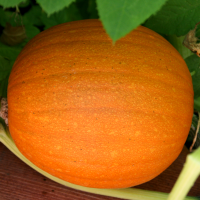Gardeners in California's Sacramento Valley often grow pumpkins the size of VW bugs. Prize winning pumpkins are so big that heavy duty pickup trucks are needed to transport single pumpkins to the judging platforms! In fact, pumpkins grown in California and Oregon can gain up to 10 pounds a day in weight during the peak growing days of the summer. These pumpkins can end up weighing over a 1000 pounds by harvest time. (In 2007 a prize pumpkin from Oregon weighed in at 1,524 pounds!) That's a lot of water weight! And the decisive term here is just that: water. On the eastern side of the Sierra, it's not impossible to grow pumpkins that end up weighing hundreds of pounds, but it's impractical and certainly not water wise.
But pumpkins are so thoroughly intertwined with the life, history and culture of the United States, that it almost seems unamerican not to grow them in your vegetable garden. Certainly, pumpkins are indigenous to North America. Utilized by Native Americans for centuries, then introduced to throngs of immigrants, the pumpkin has become so beloved in this country that the name is considered a term of endearment. They are, of course, the center of attention on Halloween and many consider Thanksgiving dinner incomplete without a homemade pumpkin pie.
Pumpkins prefer a mildly rich soil, so you don't want to over fertilize your pumpkin plants; they are easy to grow in most types of garden soil. If you over fertilize your plants, they will try to take over, but if you have room, that's not such a bad thing. But a mild organic fertilizer mix will do fine. (Stop by our shop; we have some nice organic fertilizers perfect for growing food plants.)
It's always a good idea to grow more than one vine since if anything terrible happens to one, you'll have a backup. Plus, pumpkin lovers say you can never have enough pumpkins. You can can them, freeze them, enter them into contests and give them away to your neighbors and friends for thanksgiving. If you do grow more than one vine, its fun to plant four seeds in a small mound, then train each vine to grow toward different areas of your yard.
The roots don't like to stay soggy, but being relatively fine and without tap roots, they don't like to dry out completely either. The vines like lots of sun, but they do react to intense heat. In Reno, during the hottest part of the day, the leaves will tend to wilt. This is normal behavior for our region. By the time the sun drops behind the mountains, the leaves will perk up again. If they don't, you'll probably want to increase their daily water. The best time to water is in the morning before the sun is high and hot. Here in the high desert, overhead and evening watering usually doesn't present a mildew problem, but if you have soaker hoses set up in your garden, the early morning soaking method tends to be more efficient.
Pumpkins will take the entire growing season to mature. When autumn comes, the green fruit will begin to change to orange just as the leaves of the deciduous trees are turning. The frosts will kill the leaves and vine, but the pumpkins will endure. They can even sit where they grew if the ground isn't kept continuously wet. Picked pumpkins can be kept easily on the porch. They can also be brought indoors to keep you company and to beautify the interiors of your home until Thanksgiving and Christmas dinners
If you do bring them indoors to prolong their beauty, keep them dry and cool, away from direct sunlight. Watch for cracks or brown spots. In our region, it's not uncommon to keep pumpkins well into January.
This article used by permission.


